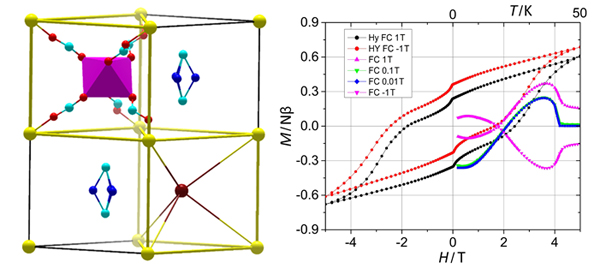[1] Kahn, O. Nature 1999, 399, 21.
[2] Kumar, A.; Yusuf, S. M. Phys. Rep. 2015, 556, 1.
[3] Néel, L. Ann. Phys. 1984, 3, 137.
[4] Markovich, V.; Fita, I.; Puzniak, R.; Martin, C.; Kikoin, K.; Wisniewski, A.; Hebert, S.; Maignan, A.; Gorodetsky, G. Phys. Rev. B 2006, 74, 174408.
[5] Ravi, P. S.; Tomy, C. V. J. Phys.:Condens. Matter. 2008, 20, 235209.
[6] Ohkoshi, S.; Hashimoto, K. J. Am. Chem. Soc. 1999, 121, 10591.
[7] Ohkoshi, S.; Abe, Y.; Fujishima, A.; Hashimoto, K. Phys. Rev. Lett. 1999, 82, 1285.
[8] (a) Nuttall, C. J.; Day, P. Chem. Mater. 1998, 10, 3050. (b) Day, P. Chem. Mater. 2003, 15, 2288. (c) Bhattacharjee, A. Chem. Mater. 2003, 15, 2287. (d) Tang, G.; He, Y.; Liang, F.; Li, S.; Huang, Y. Physica B 2007, 392, 337.
[9] Fishman, R. S.; Reboredo, F. A. Phys. Rev. Lett. 2007, 99, 217203.
[10] Zhao, J.-P.; Hu, B.-W.; Lloret, F.; Tao, J.; Yang, Q.; Zhang, X.-F.; Bu, X.-H. Inorg. Chem. 2010, 49, 10390.
[11] Cañadillas-Delgado, L.; Fabelo, O.; Rodríguez-Velamazán, J. A.; Lemée-Cailleau, M.-H.; Mason, S. A.; Pardo, E.; Lloret, F.; Zhao, J.-P.; Bu, X.-H.; Simonet, V.; Colin, C. V.; Rodríguez-Carvajal, J. J. Am. Chem. Soc. 2012, 134, 19772.
[12] (a) Zhao, J. P.; Xu, J.; Han, S. D.; Wang, Q. L.; Bu, X. H. Adv. Mater. 2017, 29, 1606966. (b) Mączka, M.; Ciupa, A.; Gągor, A.; Sieradzki, A.; Pikul, A.; Ptaka, M. J. Mater. Chem. C 2016, 4, 1186.
[13] Zhao, J.-P.; Han, S.-D.; Jiang, X.; Liu, S.-J.; Zhao, R.; Chang, Z.; Bu, X.-H. Chem. Commun. 2015, 51, 8288.
[14] Zhao, J. P.; Han, S. D.; Liu, F. C. Inorg. Chem. 2019, 58, 1184.
[15] (a) Yu, Y.; Shang, R.; Chen, S.; Wang, B.-W.; Wang, Z.-M.; Gao, S. Chem. Eur. J. 2017, 23, 9857. (b) Shang, R.; Chen, S.; Hu, K.-L.; Wang, B.-W.; Wang, Z.-M.; Gao, S. Chem. Eur. J. 2016, 22, 6199. (c) Shang, R.; Xu, G.-C.; Wang, Z.-M.; Gao, S. Chem. Eur. J. 2014, 20, 1146.
[16] (a) Zhao, Y.-H.; Liu, S.; Wang, B.-W.; Wang, Z.-M.; Gao, S. Chem. Eur. J. 2019, 25, 9303. (b) Sieradzkia, A.; Pawlus, S.; Tripathy, S. N.; Gągorc, A.; Ciupac, A.; Mączkac, M.; Paluch, M. Phys. Chem. Chem. Phys. 2016, 18, 8462.
[17] (a) Brown, I. D.; Altermatt, D. Acta Crystallogr. 1985, B41, 244. (b) Brese, N. E.; O'Keeffe, M. Acta Crystallogr. 1991, B47, 192.
[18] Llunell, M.; Casanova, D.; Cirera, J.; Alemany, P.; Alvarez, S. SHAPE, Version 2.1, Universitat de Barcelona, Barcelona, Spain, 2013.
[19] Zhao, J.-H.; Han, S.-D.; Jiang, X.; Liu, S.-J.; Zhao, R.; Chang, Z.; Bu, X.-H. Chem. Commun. 2015, 51, 8288.
[20] (a) Sun, Y.; Cong, J.-Z.; Chai, Y.-S.; Yan, L.-Q.; Zhao, Y.-L.; Wang, S.-G.; Ning, W.; Zhang, Y.-H. Appl. Phys. Lett. 2013, 102, 172406. (b) Bora, T.; Ravi, S. J. Magn. Magn. Mater. 2014, 358, 208. (c) Li, C.; Yan, T.; Chakrabarti, C.; Zhang, R.; Chen, X.; Fu, Q.; Yuan, S.; Barasa, G. O. J. Appl. Phys. 2018, 123, 093902. |
